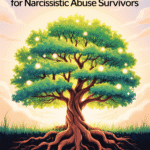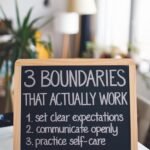Now Reading: You are Not Lazy You are Grieving
-
01
You are Not Lazy You are Grieving

You are Not Lazy You are Grieving
🧨 Let’s Just Say It: You are Not Lazy You are Grieving
If you’ve ever looked around at the laundry, the dishes, the unpaid bills, and thought:
“Why can’t I just get it together?”
Let me be the first to tell you:
It’s not laziness. It’s grief. It’s trauma. It’s survival burnout.
Narcissistic abuse doesn’t just mess with your heart — it burns out your body, your brain, and your will to act.
You’ve been living in constant alert mode. You’ve been gaslit, invalidated, minimized, guilt-tripped, and discarded. And now that the chaos is quiet?
Your body has collapsed under the weight of everything it held up for far too long.
🧠 Why This Happens: The Science of Survivor Fatigue
Here’s what most people don’t understand about survivors:
The body keeps pushing until it’s “safe” enough to break down.
Once you’re out of the narcissist’s line of fire — that’s when the exhaustion hits like a truck.
What’s happening inside you:
- 🧬 Cortisol flood from prolonged stress
- 🧠 Adrenal fatigue (yes, it’s real)
- 🩸 Dysregulated blood sugar, hormone chaos
- 🛑 Chronic inflammation = brain fog, pain, digestive issues
- 😵💫 Emotional freeze response = can’t initiate tasks, dissociate from needs
This isn’t about motivation or mindset. It’s about physiology. Your nervous system is running on fumes.
😔 The Inner Monologue of a Burned-Out Survivor
Let’s break the silence. If you’ve ever said (or thought) any of these, you’re not alone:
“I slept 10 hours but I’m still exhausted.”
“I can’t even answer a text message.”
“I used to be so productive… what happened to me?”
“I’m embarrassed. I feel broken.”
“I want to care. I just can’t.”
Here’s your permission slip: you’re allowed to rest. You’re allowed to heal. You’re allowed to not perform.
Because right now, your body is grieving. And grief is heavy.
⚠️ Why Narcissistic Abuse Makes Grief So Complex
This isn’t like grieving a regular breakup. You’re grieving:
- The person you thought they were
- The version of yourself you lost in the chaos
- Time, energy, and dreams stolen
- The family/friends who didn’t believe you
- The identity you had before trauma twisted it
And here’s the kicker? Most of this grief is invisible. People expect you to “be over it,” and when you’re still barely functioning, it makes the shame worse.
🛑 The Lie: “If You Really Wanted to Heal, You’d Be Doing More”
Narcissistic conditioning doesn’t leave quietly. Even after they’re gone, that voice lingers:
“You’re lazy.”
“You’re useless.”
“You’re wasting your life.”
It’s not your voice.
It’s theirs, echoing in your nervous system like a bad reverb effect.
Healing isn’t about doing more — it’s about doing differently.
🌱 What Recovery Looks Like (Hint: It’s Not Glamorous)
Let’s be real. Most days, healing looks like:
- Getting out of bed and that’s the win
- Crying for 20 minutes and then making a sandwich
- Deleting a toxic message instead of replying
- Staring at a wall while your nervous system recalibrates
- Resting — not as a luxury, but as a survival strategy
These moments count. Healing isn’t about proving your productivity. It’s about reconnecting to your self.
💡 What Actually Helps (Tiny But Mighty Shifts)
1.
Reframe Rest as Repair
Instead of saying “I’m being lazy,” try:
“My system is repairing. I’ve earned this pause.”
Use this like a mantra — and repeat it until your inner critic shuts up.
2.
Create Micro-Missions
Forget mile-long to-do lists. Try:
- Drink a glass of water
- Sit outside for 5 minutes
- Put on music instead of doomscrolling
- Tidy one corner, not the whole house
Success breeds regulation. Tiny wins retrain your brain.
3.
Build a Guilt-Free Recovery Routine
Here’s a sample flow:
- Morning: No phone. Breathe. One anchor thought.
- Midday: Movement snack (5 minutes). Hydration.
- Evening: Magnesium + wrap in blanket + no-pressure journaling.
- Bedtime: Affirm: “I am safe enough to rest now.”
The goal isn’t productivity. It’s nervous system safety.
4.
Redefine “Progress”
Old definition:
“Did I get everything done?”
New definition:
“Did I honor my needs and keep myself regulated — even just a little?”
Progress isn’t measured in checkboxes. It’s measured in peace.
5.
Ditch the Performative Healing Trap
You don’t need to start a trauma podcast, open your chakras, and become a yoga influencer to prove you’re healing.
You just need to breathe, rest, feel, and not gaslight yourself.
That’s enough. That’s huge.
📓 Survivor Journal Prompt
Use this when you’re spiraling into “I’m not doing enough” territory:
1. What do I feel guilty about not doing today?
2. What would I say to a friend who felt this way?
3. What does my body actually need right now?
4. What tiny thing can I do to meet that need — even 1%?
5. What do I want to remember about this moment?
🎯 Reminder: Rest Isn’t a Reward — It’s a Requirement
Let me say this plain:
You don’t have to earn rest.
You don’t have to justify your fatigue to anyone.
And you damn sure don’t need to produce your way out of your pain to be “valid.”
You’ve survived the war. Now let yourself rebuild, brick by brick — nap by nap.
And when you rest? You’re not quitting.
You’re reclaiming.
💬 Ask Eve: “Why Can’t I Get It Together?”
7 Truth-Bombs for Survivors Who Feel Burned Out, Numb, or Just… Done
1. “Why am I so tired all the time, even though I’m not doing anything?”
Oh love — you’re doing everything.
You’re surviving. You’re holding the pieces. You’re breathing through a storm you didn’t ask for.
This isn’t laziness. This is post-survival collapse. When the narcissistic chaos finally stops, your body does what it was never allowed to: fall apart.
It’s like trying to walk after running from a lion for three years. Your legs don’t work because they’re not broken — they’re exhausted. You’re not being dramatic. You’re in biological burnout. Cortisol. Adrenal fatigue. Emotional shutdown. It’s real. And it’s earned.
2. “Why do I feel guilty for not being productive? Why can’t I just push through?”
Because someone trained you to believe rest = failure.
The narcissist, society, perfectionism culture — take your pick. They taught you that your value = your output. That being still = being weak. That “not coping” = “not trying.”
That’s gaslighting. And it got under your skin.
You’re not lazy. You’re not weak. You’re not wasting time. You’re recovering from trauma in a culture that doesn’t understand it.
Give yourself what they never did: permission to rest without guilt.
3. “What if I used to be so high-functioning… and now I can’t even text back?”
Survivor burnout doesn’t care what your résumé says.
You could’ve been a CEO, a supermom, a social butterfly — trauma still rewires your brain. What you’re experiencing now? That freeze, that fog, that why-is-everything-so-hard feeling?
That’s a nervous system screaming, “Please let me catch up.”
And texting back? That’s executive function. It lives in the same part of the brain that trauma floods. So no, you’re not lazy — you’re literally in a neurobiological fog.
High-functioning before doesn’t invalidate the exhaustion now. It explains it.
4. “How can I tell the difference between burnout and just ‘being in a funk’?”
Burnout isn’t just a mood.
It’s in your body.
- You sleep but don’t feel rested.
- You eat but don’t taste.
- You try to focus but your brain feels like static.
- You want to care — but nothing sparks.
A funk passes with a nap and a walk.
Burnout? Lingers. Flattens. Disorients.
And when it comes from narcissistic abuse, it carries shame and identity loss too. That’s why “just cheer up” never works — because your soul is busy rebuilding itself from rubble.
5. “How do I even start healing when I don’t have the energy to start?”
One micro-move at a time.
Forget five-year plans or vision boards. That’s pressure. You need permission.
Try this:
- Sit by a window for 3 minutes.
- Drink a full glass of water and notice it.
- Wrap up in a blanket and exhale out loud.
- Say to yourself: “I am in repair mode.”
That’s it. That’s the beginning.
You’re not lazy for resting. You’re strategic. Because healing isn’t hustle. It’s slow. Gentle. Rebuilding your capacity one breath at a time.
6. “Why does healing sometimes feel worse than staying?”
Because surviving abuse made you numb. And healing wakes you up.
And wow — feeling again? Hurts.
You’re grieving the relationship, the version of yourself you lost, the years that went missing, the people who didn’t believe you. That grief is real — and it’s massive.
So yes, healing hurts sometimes.
But pain with purpose is different from pain without escape. This pain leads somewhere. Back to you. Back to truth. Back to life.
7. “What’s one thing I can do today to feel even 1% better?”
Let’s make it count. Here’s a no-pressure, nervous-system-safe starter menu:
- Write one sentence about how you’re really doing.
- Touch your heart and say: “I’m still here.”
- Delete one saved message from someone toxic.
- Light a candle and sit with it for five minutes.
- Say “I am not lazy. I am in repair.”
That’s not small. That’s survival work. And you’re doing it.
❤️ Final Word from Eve
You’re not falling behind — you’re falling into stillness because you’ve earned it.
You’re not broken — you’re rebuilding.
You don’t need to explain your exhaustion. Or justify your rest. Or pretend you’re “fine.”
Let go of the pressure to perform your healing.
You’ve done enough. You’ve survived. That’s enough.
Now let yourself rest — not as a reward, but as your right.
🧭 You’re Not Alone: 7 External Self-Help Resources That
Actually
Help
Let’s stop pretending healing means doing it all solo. These aren’t fluff-filled feel-good blogs — they’re real-world tools, survivor-vetted, and built to meet you where you are.
1.
MyNARA Recovery App
If you want structure, tools, and trauma-aware pacing, this app delivers. Designed specifically for survivors of narcissistic abuse, MyNARA tracks red flags, records your emotional timeline, and offers guided modules to help you stay grounded. Think of it as your digital therapist’s assistant — without the judgment or pressure.
2.
Sarah Herstich, LCSW – Nervous System Recovery
Sarah’s work zeroes in on healing the body after narcissistic abuse. If talk therapy alone hasn’t touched the depth of your burnout, her resources on somatic regulation, trauma-informed therapy, and boundary rehab are gold. Her blog posts read like permission slips — and she’s one of the few who gets it without glossing it over.
3.
Verywell Mind: Narcissistic Abuse Support Groups
Sometimes you need community before clarity. This guide breaks down where to find peer support, both in-person and online — including safe spaces that won’t gaslight you or say “forgive and forget.” You’ll find options vetted for emotional safety and recovery-forward goals.
4.
Dr. Ramani YouTube Channel
https://www.youtube.com/c/DoctorRamani
Dr. Ramani is basically the Beyoncé of narcissism education — minus the sugarcoat. Her no-nonsense videos break down complex narcissistic behaviors into digestible, affirming truths. She names the manipulation without pathologizing you — and hearing it from her mouth hits different when you’re doubting your own.
5.
Tiny Buddha: Healing From Narcissistic Abuse
This post goes deep on rebuilding self-esteem after abuse — not with woo-woo fluff but with grounded advice, inner-child validation, and slow, safe exercises. For the days you can barely move, it reads like a gentle friend who knows the whole story and isn’t in a rush to “fix” you.
6.
Out of the FOG (Fear, Obligation, Guilt)
This treasure trove of narcissism resources gives you the language, clarity, and validation you’ve been starving for. With glossaries of toxic traits, survivor stories, and tools to reduce FOG (Fear, Obligation, Guilt), this site is like your trauma-informed dictionary — and a damn good compass.
7.
Psych Central: Emotional Abuse Recovery Guide
Need to understand the trauma science and get practical with your next step? This guide mixes both: you’ll get the brain-side effects of emotional abuse and clear steps to rewire your thought patterns. The tone is smart but never smug — perfect for survivors rebuilding trust in themselves and the world.
📍3 Internal Abuse No More Guides to Keep You Anchored
These are your in-house blueprints — written for survivors, by survivors, with the IMC Method™ woven through every word.
1.
The IMC Method™ Explained
https://abusenomore.com/imc-method
This is your north star. The IMC Method™ breaks down narcissistic manipulation into three tactical moves: Identify, Minimize, Control. It’s not a concept — it’s a survival framework that helps you regain clarity, set boundaries, and take your life back on your terms.
2.
You’re Not Lazy — You’re Grieving
https://abusenomore.com/not-lazy-youre-grieving
For the days when showering feels like climbing Everest and shame whispers “You’re useless,” this piece pulls you back into reality: you’re not broken — you’re healing. From adrenal fatigue to the grief nobody sees, this article is the nervous-system validation you didn’t know you needed.
3.
How to Find the Right Therapist After Narcissistic Abuse
https://abusenomore.com/therapy-after-narcissistic-abuse
Not all therapists get narcissistic abuse. In fact, most don’t. This guide walks you through screening questions, red flags to watch for, and how to spot trauma-informed care that actually helps. If you’re tired of explaining your trauma to the person who’s supposed to treat it — start here.















